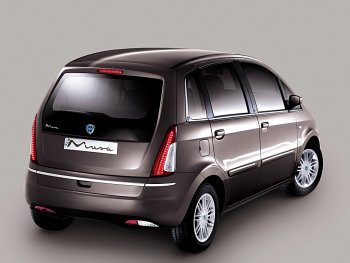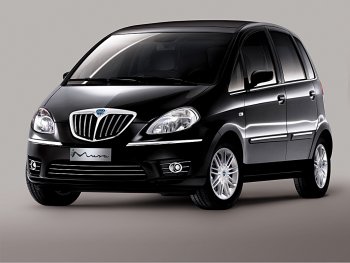|
Generous engines
for an enjoyable drive
|
|
The engines in
the range guarantee a perfect balance between performance,
consumption and respect for the environment. The range
comprises three Multijet turbodiesels: the round, elastic
1.9 delivering 100 bhp, and two 1.3 units delivering 70 or
90 bhp, which are perfect in town when combined with the
sequential robotised DFN gearbox (the 90 bhp version is
available with the option of a particulate trap). There are
also two petrol engines: a 1.4 delivering 77 bhp, and a 95
bhp 1.4 Fire (also available with the DFN gearbox).
The 100 bhp 1.9 Multijet
This is a 1.9 Multijet engine (Common rail with multiple
injection) with 4 cylinders in line, bore of 82 mm and
stroke of 90.4 mm. There are two valves per cylinder,
activated directly by an overhead camshaft.
The Common Rail system adopted by the 100 bhp 1.9 Multijet
incorporates two automatic strategies to control calibration
and balancing of the injected diesel fuel, making for
quieter operation and reducing vibration. The combustion
chamber has also been optimised to improve the thermodynamic
efficiency, reducing the compression ratio to 18:1.
Turbocharging on the engine is a fixed geometry turbo fitted
with an electronic Waste Gate valve, which improves power
delivery while guaranteeing high torque even at low engine
speeds. Suffice it to say that 90% of peak torque is
available between 1750 and 3250 rpm, and this translates
into extremely enjoyable driving and sparkling performance.
The 1.9 Multijet features an extremely quiet heating-up
stage and excellent power delivery (100 bhp at 4000 rpm)
combined with generous torque (26.4 kgm at 1750 rpm). With
this engine, the new Musa reaches a top speed of 179 km/h,
accelerating from 0 to 100 km/h in 11.5 seconds, and from 0
to 1000 m in just 33 seconds. Sparkling performance, but low
consumption: 6.5 l/100 km in the urban cycle, 4.4 l/100 km
out of town and 5.2 l/100 km on the combined cycle.
Like the 1.3 Multijet, the 1.9 Multijet belongs to the
family of second generation Common rail engines. They share
the same principles as the original Common rail engines:
high injection pressure and electronic injector control. But
with an additional feature: the number of injections
increases during each engine cycle. Inside the cylinder, the
quantity of diesel fuel burned remains the same, but it is
broken down into several parts for more gradual, more
complete combustion. The secret of the Multijet lies in the
electronic control unit that governs the opening and closing
of the injectors, which can make them perform a series of
very close injections.
There are three main advantages over the first generation
Common rails: quieter operation, lower emissions and boosted
performance.
The 90 bhp and 70 bhp 1.3
Multijet 16v
The new Musa range would not be complete without the 1.3 16v
Multijet engine, the smallest and most advanced second
generation direct injection Common rail diesel unit, now
available in two power levels: 90 bhp and 70 bhp.
Thanks to a variable geometry turbo the first version
Multijet delivers a maximum of 90 bhp (66 kW) at 4000 rpm
and torque of 200 Nm (20.4 kgm) at 1750 rpm. That is not
all. With the 90 bhp 1.3 Multijet, the new Musa guarantees
excellent performance: it accelerates from 0 to 100 km/h in
12.5 seconds, from 0 to 1000 m in 34 seconds and has a top
speed of 173 km/h. Fuel consumption is 6.0 l/100 km in the
urban cycle, 4.0 l/100 km out of town and 4.7 l/100 km in
the combined cycle.
A number of changes have been made to the new engine, in
addition to the different turbo (the turbo on the 70 bhp 1.3
Multijet is of fixed geometry type). The combustion system
has been modified, increasing the permeability of the inlet
and exhaust manifolds, reducing the turbulence in the
combustion chamber and consequently modifying the geometry
and the compression ratio from 18:1 to 17.6:1. The emissions
control system includes an EGR valve with electrical
activation, managed directly by the engine control system, a
heat exchanger to cool the recirculating exhaust gases (EGR)
and a close coupled catalytic converter. This guarantees
that the car meets the EEC STAGE 4 emissions targets.
Performance is also excellent from the 70 bhp 1.3 Multijet:
70 bhp at 4000 rpm (51 kW) and peak torque of 180 Nm at just
1750 rpm.
|
 |
|
 |
|
Equipped with this engine the Musa has a top speed
of 159 km/h, accelerates from 0 to 100 km/h in 15.4 seconds,
and from 0 to 1000 m in 36.6 seconds. Fuel consumption is
also among the best in this segment: 6.0 l/100 km in the
urban cycle, 4.2 l/100 km out of town and 4.9 l/100 km in
the combined cycle.
Those are the differences between the 70 bhp and 90 bhp
versions; however they both share the same architecture.
They are both straight-4 engines with a capacity of 1248 cc,
a bore of 69.6 mm and a ‘long’ stroke of 82 mm. There are
four valves per cylinder, activated directly by a twin
overhead camshaft. That is not all. The 1.3 Multijet 16v is
a miniature masterpiece of technology: ‘dressed’ with all
its accessories, it weighs just 130 kg, it is small, less
than 50 cm long and 65 cm tall, and the component layout was
designed to take up as little space as possible.
Designed to respect criteria of maximum rationality,
efficiency and reliability, the engine guarantees excellent
efficiency and is practically ‘for life’: it was designed to
travel 250,000 km without needing any maintenance to the
mechanicals. Oil change intervals have also been extended,
from 20,000 to 30,000 km, and the 1.3 Multijet 16v uses a
low viscosity oil, which means fuel economy and more respect
for the environment.
The compact, sophisticated 1.3 Multijet 16v (both 70 bhp and
90 bhp) represents a technological leap forward which, for
the customer, translates into lower consumption and
emissions, without even taking into consideration the
reduction in noise (due to the multiple injections), the
increase in comfort (fewer alternating masses means less
vibration), the smooth, responsive steering (due to the
extremely smooth torque delivery, which in turn is
guaranteed by the improved combustion control), the
elasticity and prompt response of a diesel that resembles a
petrol engine for the vast excursion in the number of revs
(for example, you are no longer aware of the fuel ‘cut-out’
just above 4000 rpm), or the ecological characteristics that
enhance the diesel’s main environmental credentials
(consumption) while minimising its main defect (particulate
emissions).
The 77 bhp and 95 bhp 1.4
16v Fire
The new engine has a capacity of 1368 cc, and 4 cylinders in
line, bore of 72 mm, stroke of 84 mm, and two valves per
cylinder (four on the 95 bhp version). The engine was
developed paying particular attention to performance and to
fuel economy, two areas in which the new Musa leads its
class. The merit goes to the volumetric efficiency which has
been optimised all through the operating range, thanks to a
specific fluid-dynamic calibration of the entire intake
system and of the timing.
There is a choice of two versions: the first delivers 57 km
(77 bhp) at 6000 rpm, and peak torque of 11.7 kgm at 3000
rpm. It has a top speed of 163 km/h and accelerates from 0
to 100 km/h in 13.5 seconds. Consumption is particularly
low: 7.9 l/100 km in the urban cycle, 5.2 l/100 km out of
town, and 6.2 l/100 km in the combined cycle.
The new Musa can also be equipped with another 1.4 Fire
engine, which delivers 70 kW (95 bhp) at 5800 rpm, and peak
torque of 13 kgm at 4500 rpm. With this engine the Lancia
Musa has a top speed above 175 km/h, accelerates from 0 to
100 km/h in 11.5 seconds and from 0 to 1000 m in 33 seconds.
But consumption remains good: 8.7 l/100 km in the urban
cycle, 5.4 l/100 km out of town, and 6.6 l/100 km in the
combined cycle. A sparkling yet parsimonious engine that
delivers excellent performance, achieved thanks also to the
electronic throttle valve control system known as ‘drive by
wire’.
The engine is also completely compatible with devices
such as ESP and Cruise Control. The 1.4 16v Fire engine
delivers high torque values at low speeds, characteristics
that make it possible to limit fuel consumption. Emissions
respect Euro 4 legislation, thanks to the catalytic
converter in the engine bay, which reaches very high
temperatures faster, thus reducing emissions even while the
engine is warming up. To minimise the environmental impact,
the engine also incorporates a returnless fuel supply
system, which eliminates fuel recirculation within the tank,
and reduces vapour formation.
Exciting, sparing on fuel and clean: to these
characteristics, the 95 bhp 1.4 16v Fire engine adds
excellent acoustic comfort. To reduce the vibration
transmitted from the engine to the bodyshell to a minimum, a
barycentre engine support system has been adopted, so as to
obtain reaction forces with a neutral link. |
|